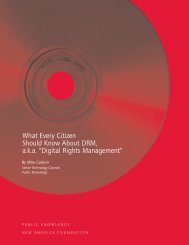Testimony of David Wolfe, Creative Director The ... - Public Knowledge
Testimony of David Wolfe, Creative Director The ... - Public Knowledge
Testimony of David Wolfe, Creative Director The ... - Public Knowledge
You also want an ePaper? Increase the reach of your titles
YUMPU automatically turns print PDFs into web optimized ePapers that Google loves.
E s s a y s : Ready t o S h a r e<br />
ready to share:<br />
creativity in fashion & digital culture<br />
page 28 | Ready to Share: Fashion & the Ownership <strong>of</strong> Creativity<br />
Pastel hues <strong>of</strong> famed<br />
artist Cecil Beaton<br />
shimmer anew in<br />
this contemporary<br />
evening gown.<br />
BY DAVID BOLLIER<br />
AND LAURIE RACINE<br />
Anyone who ventures onto the Internet quickly discovers that the creative spirit is riotously<br />
alive. On any given day, 8 million bloggers forage the deep forests <strong>of</strong> the World Wide Web<br />
for twigs and leaves <strong>of</strong> information, which they weave into personal nests. Remix musicians<br />
sample snippets <strong>of</strong> music and ambient sounds, synthesizing them into startling new musical<br />
creations. Tens <strong>of</strong> thousands <strong>of</strong> s<strong>of</strong>tware programmers collaborate in building soaring<br />
cathedrals <strong>of</strong> code, which run operating systems, Web sites, document archives and much<br />
more. Filmmakers and photographers pore through archives <strong>of</strong> public domain and privately<br />
owned material searching for the perfect images from which to create new visual works.<br />
<strong>The</strong> open, participatory culture found on the Internet<br />
and other digital media is perhaps the defining crucible<br />
<strong>of</strong> creativity in our time. Guided by a sensibility that<br />
appropriates from irregular materials that exist in other<br />
contexts and forms, the Internet has redefined the way<br />
we express ourselves and relate to culture. Structuralist<br />
Claude Levi-Strauss once described this recombinant creative<br />
process as bricolage 1 , a concept that refers to the constant<br />
mixing and morphing <strong>of</strong> incongruous “found” elements into<br />
a new synthesis.<br />
But is this environment <strong>of</strong> open borrowing and transformation<br />
a liberating place for the imagination — or simply a<br />
state <strong>of</strong> lawless anarchy in which pirates prey upon the work<br />
<strong>of</strong> the truly creative and hard-working? Can a cultural milieu<br />
truly flourish without strong intellectual property rights and<br />
market control over creative work? Or, to the contrary, is a<br />
deliberately unstructured, uncontrolled environment one <strong>of</strong><br />
the most powerful ways to nurture innovation?<br />
We believe that the world <strong>of</strong> fashion — known for its<br />
embrace <strong>of</strong> appropriation, derivation and imitation, and for<br />
its ferocious attention to the bottom line — can shed light<br />
on these questions. It can help us understand the social and<br />
cultural wellsprings <strong>of</strong> creativity as well as the plasticity <strong>of</strong><br />
the marketplace. <strong>The</strong>re are, in fact, many ways that the raw<br />
social and human energy known as creativity can be refined<br />
and packaged as it travels from the human mind and social<br />
groups to the marketplace. This reality is on display not only<br />
in the world <strong>of</strong> fashion, but also in the growing universe <strong>of</strong><br />
digital culture. <strong>The</strong> “ecologies <strong>of</strong> creativity” in both realms<br />
are strikingly similar.<br />
In sharp contrast, other creative sectors like music and<br />
film remain committed to business models that value ownership<br />
and control <strong>of</strong> content above all else. To listen to music<br />
and film executives, much <strong>of</strong> what passes for “creativity” in<br />
the digital world is nothing less than theft. <strong>The</strong>se business<br />
leaders argue that strict copyright controls are necessary if<br />
anyone is going to have sufficient incentive to create new<br />
works. Yet to many artists who live and create via electronic<br />
networks, creativity has never been more robust and<br />
innovative precisely because, thanks to new technologies,<br />
copyright protections are relatively lax.<br />
<strong>The</strong> core issue in this debate between intellectual<br />
property protectionists and cultural renegades is the control<br />
<strong>of</strong> creativity. Does creativity need to be controlled strictly<br />
page 29





